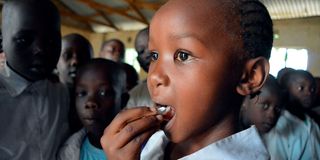State targets 6m learners in deworming campaign

Young Alice Atieno, 6, takes a deworming tablet during the national launch of the school-based deworming programme at Ombeyi Primary School in Nyando, Kisumu on February 28, 2018. The Ministry of Health is gearing up for a major deworming initiative starting in January.
The Ministry of Health is gearing up for a major deworming initiative which will be rolled out when classes resume in January.
The ministry seeks to deworm six million school-age children.
This is part of the government’s efforts to control neglected tropical diseases (NTDs), particularly bilharzia and intestinal worms, involving an expanded mass drug administration (MDA) programme.
This follows two major studies which were conducted in 12 counties — six in Coast and six in the Lake Victoria basin — early this year to determine the prevalence and intensity of bilharzia and intestinal worm infections.
The study found that Lake Victoria is the main source of transmission for bilharzia, with the prevalence rising in areas closer to the lake.
Ms Florence Wakesho, medical parasitologist at the Ministry of Health, said:“We understand that communities with poor hygiene practices or with lack of access to clean water are more at risk of these diseases but it’s important for us to also communicate that there are risk factors that expose people in urban areas such as [not] washing hands and or [not] washing vegetables, for example.”
The deworming strategy is complemented by effective collaboration with the water, sanitation and hygiene (Wash) sector to ensure sustainable implementation and reduce reinfection through behaviour change communication.
Since the distribution of bilharzia cases across the country tends to be highly focused, more accurate mapping can help better target MDA locations.
In the course of last year, the NTD programme at the Health ministry treated over 10 million people.
The initiative was partly supported by the Accelerate Resilient, Innovative, and Sustainable Elimination of NTDs (Arise) Fund, which is managed by the End Fund, a leading philanthropic fund solely dedicated to ending NTDs.
Arise Fund supports Kenya’s efforts to integrate NTD programme delivery within existing health systems.
Kenya has reached six million school-age children who were dewormed in areas well-known for worm infestation in the past decade. Next year, the country is targeting six million school-age children for treatment.
An estimated nine million people in Kenya are believed to be currently infected with the parasite that causes intestinal and urogenital infection, while an additional 17.4 million are considered to be at risk of infection.
“The number of people affected and at risk is high compared to the population of Kenya and when we look at some of the impacts of the diseases in their lives on a daily basis, it’s currently unquantifiable but it’s important to note that it makes them unable to contribute economically and socially for various reasons,” said Ms Wakesho, the medical parasitologist at the Health ministry.
People are often infected during routine agricultural, domestic and occupational activities such as car washing, sand harvesting, fishing and recreational ones, which expose them to infection from contaminated waters.
Ms Wakesho added: “When we go door to door, we are often asked when the next deworming activities will be; that gives me energy to keep going and it gives me assurance that we are making a difference in the society.”
In Kenya, Coast, Central, Eastern and the Lake Victoria regions are considered endemic areas for bilharzia and intestinal worm infections.
Even though Kenya has successfully implemented the World Health Organization (WHO) recommended treatment strategy for bilharzia, which requires repeated treatment of school-age children, the Health ministry has faced challenges in achieving optimal control of infection, or even the more ambitious goal of eliminating transmission altogether, because of financial constraints.
Through the two recent studies done in Kenya, a clearer picture of infection within the endemic areas emerged, as the focus of the survey narrowed from the county to sub-county, then to the ward and on to site levels. This suggests that the aggregation of prevalence data at higher administrative units masks the true picture of infections, especially for a focal disease such as bilharzia, for example, and emphasizes the utility of mapping.
According to Ms Wakesho, what needs to be done now is bringing the responsibility to the communities and getting them more involved. “So far, we had been pushing from the policy side, the implementers’ side and the healthcare side, but now we need the community to get involved. We don’t need to think for them on what is good but we need them to think of solutions that will work for them,” she said.





